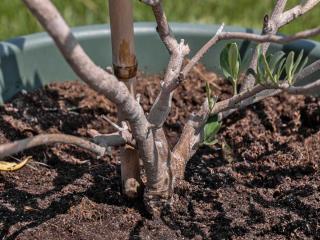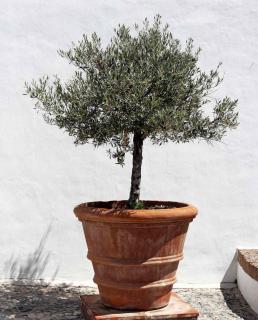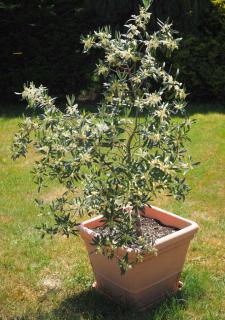

Potted olive trees are a great idea to decorate a deck.
Potted olive tree key facts
Name – Olea europea
Family – Oleaceae
Type – fruit tree
Height – 3 to 10 feet (1 to 3 m)
Exposure – full sun
Soil – soil mix
Foliage – evergreen – Harvest – autumn
Caring, pruning and watering all let your potted olive trees grow well and bear olives, even on a terrace.
Follow our tips on growing and caring for beautiful olive trees:
Growing olive trees in pots is perfectly possible since they adapt well:

A pot will sustain growth up to three times wider than the pot itself.
Growing plants in pots, and specifically olive trees, requires that certain rules be followed as regards watering.
 Annual pruning is recommended at the beginning of spring.
Annual pruning is recommended at the beginning of spring.
Potted olive trees prefer light pruning yearly instead of severe pruning every two or three years.
Add olive tree fertilizer to get magnificent olive trees.
They need cool winters, and normally resist frost spells as long as they are short and not too harsh.
If the temperature drops for some time below 23°F (-5°C), protect them with horticultural fleece and wrap the pots with a cover to protect the roots from the cold.
In case of harsh freezing, it is necessary to bring olive trees indoors in a well-lit room where the temperatures never drop below 32°F (0°C).
 Olive trees are enchanting, merely mentioning their name brings to mind images of Provence and of the Mediterranean!
Olive trees are enchanting, merely mentioning their name brings to mind images of Provence and of the Mediterranean!
This tree has a lifespan that extends over a thousand years. It is typical of Mediterranean regions, but it can be found already in more temperate climates such as along the Atlantic coast.
Its edible fruits are olives and are most often seen to be black or in shades of green.
They can be eaten raw, or spiced with garlic, basil or any from a number of other spices.
They also are the source of olive oil, famous for its many health benefits!
In cooler climates and in case it freezes hard, cover your olive trees with horticultural fleece to protect them from the cold, and wrap the pot itself with a cover to protect the roots.
Read also: